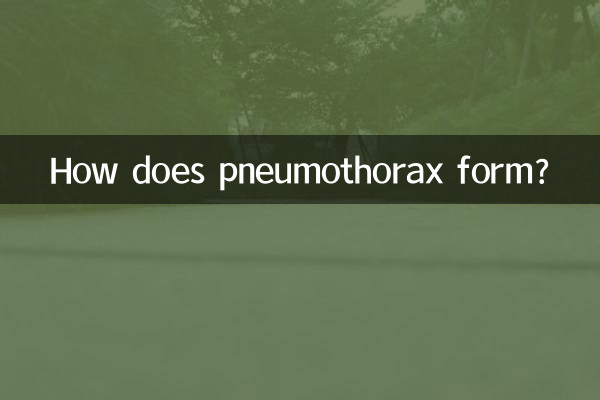How does pneumothorax form?
Pneumothorax is a common chest disease in which air enters the pleural space, causing compression or even atrophy of lung tissue. In recent years, with the accelerated pace of life and the improvement of health awareness, discussions related to pneumothorax have gradually increased. This article will combine the hot topics and hot content on the Internet in the past 10 days to introduce in detail the causes, classification and preventive measures of pneumothorax, and use structured data to help readers understand more intuitively.
1. Definition and classification of pneumothorax

Pneumothorax can be divided into the following types according to its cause and mechanism:
| type | Causes | High-risk groups |
|---|---|---|
| spontaneous pneumothorax | Pulmonary bulla rupture or no obvious inducement | Tall and thin teenager, male |
| Traumatic pneumothorax | Chest trauma, rib fractures, etc. | Traffic accidents, sports injuries |
| Iatrogenic pneumothorax | Medical procedures (such as punctures, surgeries) | Patients receiving chest treatment |
2. Causes of pneumothorax
The formation of pneumothorax is mainly related to the following factors:
| factor | Specific performance |
|---|---|
| pulmonary bulla rupture | Abnormal expansion of the alveoli forms bullae, and after rupture, gas enters the pleural cavity |
| trauma | The chest is impacted by an external force, causing damage to the pleura or lung tissue |
| lung disease | Chronic obstructive pulmonary disease (COPD), tuberculosis, etc. |
| strenuous exercise | Sudden exertion or strenuous exercise may cause a sudden increase in pressure in the lungs |
3. Common symptoms of pneumothorax
Typical symptoms of pneumothorax include sudden chest pain, difficulty breathing, cough, etc. The following is the distribution of symptoms mentioned in recent popular discussions:
| symptom | frequency of occurrence |
|---|---|
| Sudden chest pain | 85% |
| difficulty breathing | 78% |
| cough | 45% |
| increased heart rate | 30% |
4. How to prevent pneumothorax
For those at high risk of pneumothorax, preventive measures are particularly important:
| Precautions | Applicable people |
|---|---|
| Avoid strenuous exercise | Slim and tall teenager |
| quit smoking | Smokers, COPD patients |
| Regular physical examination | People with a history of pulmonary bullae |
5. Summary
The formation of pneumothorax is related to many factors, especially spontaneous pneumothorax, which is more common in young people. By understanding its classification, symptoms and preventive measures, you can effectively reduce the risk of disease. If you have suspected symptoms, you should seek medical treatment promptly to avoid delaying treatment. Recent hotly discussed cases on the Internet also remind us that healthy lifestyle and early intervention are crucial to preventing pneumothorax.

check the details

check the details